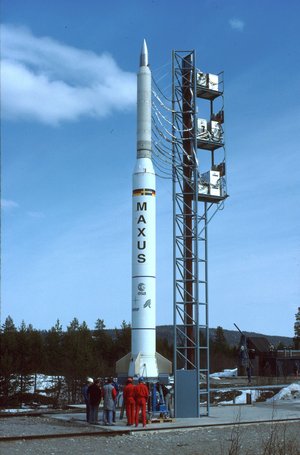Maxus 5 prepares for launch
Final preparations are underway for tomorrow’s launch of the Maxus 5 sounding rocket from Esrange, near Kiruna in northern Sweden. Scientists from four European countries have prepared five experiments for the Maxus 5 mission, which is funded by the European Space Agency.
During the past week scientists and engineers have been working together at Esrange to prepare the experiments. Over the weekend rollout of the complete payload took place, followed by installation onto the launcher. After a successful test countdown this morning, the launch is planned for 07:00 CEST (05:00 GMT) on Tuesday 1 April.
Maxus, a joint venture of the Swedish Space Corporation and Astrium, is the largest sounding rocket project in the European microgravity sounding rocket programme.
Mission scenario

The rocket, an 11.5-tonne solid-fuelled Castor 4B, will carry a 488 kg scientific payload of five experiments. The experiments are arranged in five independent modules, with the whole package including nine video cameras. Telemetry links will continuously send data back to the scientists based at Esrange. Some experiments will also have a telecommand uplink whereby vital experiment parameters can be controlled from the ground.
The Maxus 5 flight will provide weightlessness to the experiments for about 12.5 minutes. During the flight, the payload will reach an altitude of 710 km. Returning to Earth, at an altitude of 6 km the main parachute will open to ensure the safe landing of the Maxus 5 payload at a distance of about 80 km down-range. The payload will be recovered using a helicopter, normally within one hour after impact. A second helicopter will be used to return sensitive biological samples to the ground station.
Five experiments

During the time of weightlessness five experiments from Belgium (1), France (2), Germany (1) and Italy (1) will be conducted. The scientists have worked with engineering teams from Astrium GmbH (D), DTM (I), MARS Center (I), Galileo Avionica (I), Techno-System Development (I), Lambda-X (B) and the Swedish Space Corporation (S) to develop the experiment hardware.
One experiment in plant biology will study the movement of tiny particles in plant cells, called statoliths. The scientists from the University of Bonn in Germany are trying to understand further how plants sense gravity and how they use gravity to direct the growth of their roots and shoots. In particular they will be looking for the level at which the statoliths are able to detect gravity. Understanding the ability of plants to sense and respond to gravity is important to the evolution of plants on Earth and might even help to predict how life could evolve in different gravitational environments, such as onboard a spacecraft, or on other planets.

Another experiment will investigate a curious effect called Marangoni convection. Thermal convection due to density differences, as we know it on Earth, is greatly reduced in microgravity. But in the absence of gravity another convection mechanism exists, one that is driven by the variation of surface tension with temperature. The team from the University of Naples in Italy will be examining Marangoni convection using droplets of fluid. They hope to get a better insight into processes that involve droplets such as spray painting and combustion in engines.
A team of material scientists from the University of Leuven will investigate how zeolite crystals form in weightlessness. Zeolites are low-density crystalline silicates with a microporous structure. They are extensively used in commercial applications as catalysts, adsorbents and sensors. The synthesis of zeolite materials requires a good understanding of the molecular mechanisms involved.
An experiment in fundamental physics will look at the effect of vibration on the behaviour of granular matter and supercritical fluids in microgravity.
The fifth experiment deals with the biological system (tubuline) that shows macroscopic self-ordering by reaction-diffusion processes, which are gravity dependent. The type of structure that forms depends on the orientation of the sample with respect to gravity at the critical moment during early stage of development of the self-organised state. Theory predicts, and a first experiment on the Maxus 3 flight in 1999 showed, that in microgravity there is no self-organisation of the microtubules. The scientists will confirm this in a further experiment during the Maxus 5 campaign.
Why are experiments flown on sounding rockets?

Sounding rockets such as Maxus 5 give scientists a cost effective way to perform experiments in a microgravity environment for a reasonable length of time, typically providing microgravity that is as low as 0.0001g. Sounding rockets also offer other advantages to the scientists, such as:
Nearly no safety constraints – compared to manned flights, there are nearly no safety constraints affecting the materials used in the experiments
Interactive operations – for experiments with a video downlink, the scientists are able to control the experiment from the ground station, or even the scientist’s own laboratory, via satellite, or nowadays via ISDN lines
Late access – samples can be placed in the launcher up to one hour before liftoff
Early retrieval - payloads can be recovered quickly and returned to investigators so that they can do detailed scientific evaluation in their home laboratories
- Re-use of hardware - a significant part of the flight hardware is re-used for other similar experiments on the next sounding rocket missions helping to reduce the costs.
Future flights
The development of more sounding rocket experiments is already underway, with the next ESA flight due to take place in November 2004 and other flights planned for 2005.
Maxus 5 web site
For more information about the Maxus 5 mission, see the special web site at http://maxus5.marscenter.it















 Germany
Germany
 Austria
Austria
 Belgium
Belgium
 Denmark
Denmark
 Spain
Spain
 Estonia
Estonia
 Finland
Finland
 France
France
 Greece
Greece
 Hungary
Hungary
 Ireland
Ireland
 Italy
Italy
 Luxembourg
Luxembourg
 Norway
Norway
 The Netherlands
The Netherlands
 Poland
Poland
 Portugal
Portugal
 Czechia
Czechia
 Romania
Romania
 United Kingdom
United Kingdom
 Slovenia
Slovenia
 Sweden
Sweden
 Switzerland
Switzerland





























